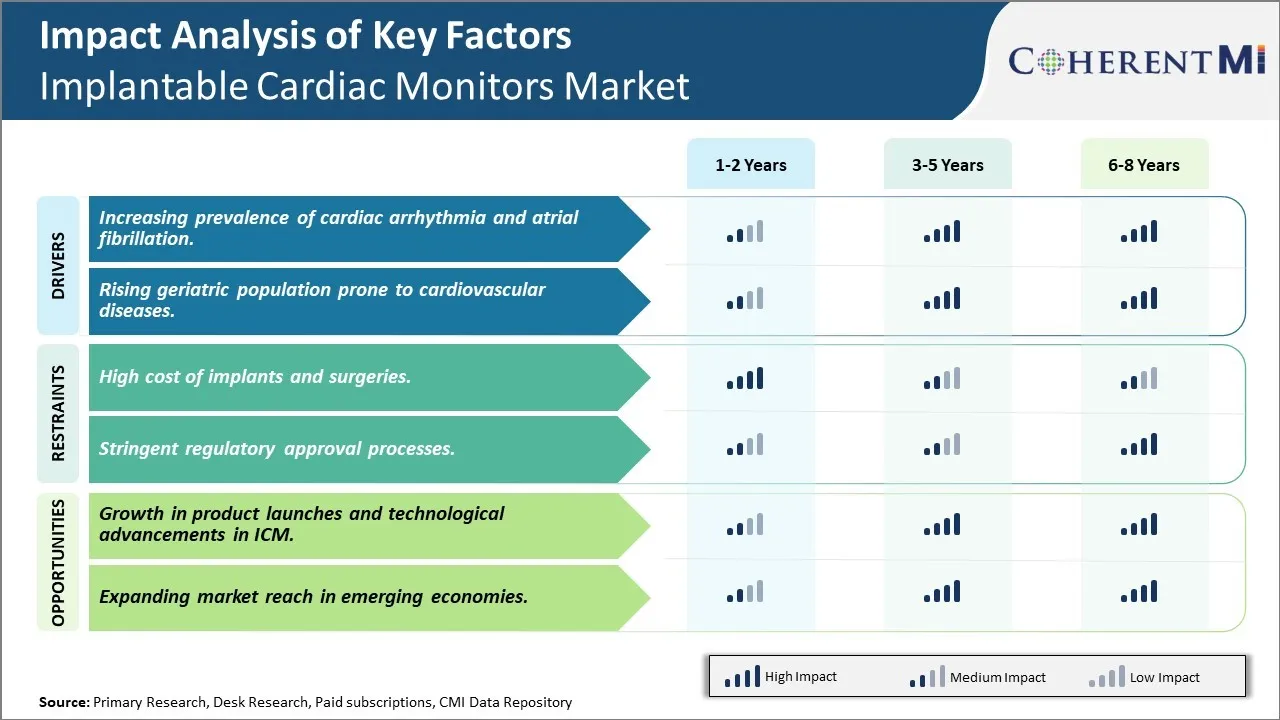可种植心电图市场 规模与份额分析 - 成长趋势与预测 (2024 - 2031)
可栽培的心肌监测器市场按应用(心律失常、试纤维化、其他)、终端用户(医院和诊所、家庭设置、门诊中心、其他)、地理(北美、拉丁美洲、亚太、欧洲、中东和非洲)分类。 本报告为上述部分提供了价值(10亿美元)。....
可种植心电图市场 规模
市场规模(美元) Bn
复合年增长率5.13%
| 研究期 | 2024 - 2031 |
| 估计基准年 | 2023 |
| 复合年增长率 | 5.13% |
| 市场集中度 | High |
| 主要参与者 | 美敦力学, 亚伯特, 生物遥测, 波士顿科学公司, Biotronik SE & Co. KG. 生物工程公司 以及其他 |
请告诉我们!
可种植心电图市场 分析
可植入的心脏监测器市场估计价值为: 2024年1.1 Bn美元 预计将达到 美元 1.6 Bn 到2031年以复合年增长率增长 (CAGR)从2024年到2031年占5.13%. 心律失常的发生率不断上升,以及对这类病人进行远程监测的重要性不断提高,预计将在预测期间推动对可植入的心脏监测器的需求。
植入式心脏监测器市场预计将出现显著增长,因为老年人口增多,更容易出现心律失常。 此外,人们日益认识到长期心脏监测和偿还费用的好处,这是预期能促进市场的因素。 然而,与设备召回有关的问题和漫长的核准时限可能阻碍市场增长。
可种植心电图市场 趋势
市场驱动力 -- -- 心律失常和试管纤维化发病率上升
在过去几十年中,全球心律失常和试管纤维化的流行率持续上升。 这些条件发生于协调心跳的电信号被中断,导致心脏跳动过快,过慢或不规则. 造成发病率上升的一些关键因素包括人口老化、吸烟等不健康的生活方式行为、酒精消费过度和肥胖、高血压和糖尿病等其他慢性疾病发病率上升以及诊断能力提高。
今天,仅试纤维化就影响到全世界3 000多万人,是中风、心脏衰竭和其他心脏并发症的重要原因。 由于预期寿命较长,心血管风险因素负担沉重,这在发达国家更为常见。 据估算,到2030年,有近1200万美国人有可能出现试纤维化. 尽管大多数心律失常一般都是很好的,但根据严重程度,有些可能危及生命. 为了有效管理这些条件,防止不良结果,必须密切监测心脏节奏.
可栽培的心脏监测器已成为对疑似心律失常或晕厥的患者进行长期心脏监测的重要诊断工具. 与常规的外部套装或事件监视器相比,它们可以长时间持续检测和记录心律不全. 这有助于医生更好地了解经常间歇性心律失常,并确定适当的治疗方法。 人们对早期发现和管理心律节律失调症的益处的认识日益提高,因此对长期连续心脏监测装置如植入式心脏监测器的需求增加。 随着人口老化和风险因素的日益普遍,需要监测的心律失常和试纤维化病例预计在未来数年会急剧上升。
市场驱动力 -- -- 容易患心血管疾病的老年人口增加
老年是心血管疾病发展的主要不可改变的风险因素之一. 与衰老有关的生理变化,如动脉僵硬,心肌质量下降,心血管调节的改变,使得心血管系统变弱,随着时间的推移更容易受疾病影响. 目前,65岁及以上人口约占发达国家总人口的8-10%。 但是,根据联合国的估计,这一人口正在迅速增长,预计到2050年将增加一倍。
由于预期寿命延长和出生率下降,发展中国家的老年人口比例也在持续上升。 人口中的老年人口面临与高血压、糖尿病、COPD以及心律失常等老龄化通常相关的更重的医疗疾病负担。 研究表明,与较年轻的人口相比,成年人患审判性纤维化的可能性要高两至三倍。 即使小的心律不全,在青年中可能似乎没有问题,但是由于年老时普遍存在的虚弱和其他病症,对老年人来说也可能造成更大的风险。 因此,在老年病人中,持续监测心脏节奏更加重要。
可植入的心脏监测器发现,老年人广泛采用长期心脏监测方法。 他们能够持续地跟踪心脏节奏,同时不干扰用户的日常活动,这对老年患者来说具有很大的优势. 通过这些装置及早发现心律失常有助于指导及时的临床干预和优化医疗管理,以防止不良后果. 随着预计未来几十年全球老年人口稳步上升,对心脏监测解决方案的需求,如专门为老年人口设计的可植入监测器,可能会加快步伐。

市场挑战 -- -- 植入和手术成本高
可移植心脏监测器的高昂成本和与其植入相关的手术对可移植心脏监测器市场的成长构成重大挑战。 可植入的心脏监测器是一种昂贵的医疗器械,单个器械的成本从5000美元到1000美元不等. 此外,植入这些装置所需的外科手术程序也是昂贵的程序,通常在医院或流动外科中心进行。 植入ICM通常需要在当地麻醉下进行小手术,如果外科设施,麻醉和手术的费用全部增加,则可能花费1000到2000美元. 对于许多病人和保健系统来说,这些高昂的程序费用是采用和广泛使用可移植心脏监测器的障碍。 由于全球保健预算承受越来越大的压力,为这种昂贵的心脏程序提供保险或补偿造成了困难。 这种高昂的护理总成本可能限制植入式心脏监测器的全部市场潜力。
市场机会 -- -- ICM产品推出和技术进步的增长
植入式心脏监测器市场由于这些医疗器械正在进行的产品发射和技术进步,拥有强劲的增长机会。 过去几年来,制造商进行了重大创新,引进了功能强化的新的ICM产品。 许多新设备现在拥有更多的存储器来存储心脏信息,改进了无线数据传输能力,以及更小的尺寸以方便植入. 一些产品还整合了人工智能算法,以更好地分析心律失常. 这种创新正在帮助可植入的心脏监测器作为可行的诊断工具在医生和病人中受到欢迎。 此外,随着主要医疗器械公司继续投资于研发工作,预计今后几年将推出具有远程病人监测和综合心脏疗法交付等特征的更先进的综合医疗。 这些正在进行的产品改进和新的提供将吸引更多的用户,并有助于植入式心脏监测器市场长期扩大。
关键参与者采用的关键制胜策略 可种植心电图市场
开发具有先进特色的创新产品是市场领袖的赢家战略。 例如,Medtronic在2017年推出了Reveal LINQ插入式心脏监视器,这是世界上最小的可插入式心脏监视器. 其小尺寸和与磁共振成像的兼容性提供了比替代品更大的优势。 这帮助美敦尼奇获得了重大的市场份额.
获得创新的初创企业帮助大型角色融入了新技术. 例如,2018年,Abbott收购了St.Jude Medical,获得了包括确认诊断系统在内的大量可插入心脏监测器。 这扩大了Abbott的产品提供以及满足各种病人需求的能力.
突出远程监测和这些装置方便的好处的激进营销运动提高了病人的接受程度。 例如,Medtronic仅2018年就花费了9500万美元用于其启示LINQ的广告. 这种强有力的推广增加了美国等关键市场对该产品的吸收。
Biotronik等制造商注重开发低成本设备,以进入对价格敏感的发展中市场。 它于2015年以30%的低成本推出的Everion线,有助于在拉丁美洲和亚太地区获得可观的市场份额。
与医院、保健系统和付款人建立伙伴关系有助于推动偿还费用并增加无障碍性。 例如,Abbott与美国主要医院和保险公司的勾结使得其确认监测器对病人来说更便宜。
分段分析 可种植心电图市场
透视, 按应用 : 心律不全,占市场份额最高
在应用方面,心律失常子区占市场份额最高,为45.7%,原因是流行率和风险因素不断上升。 心律失常(Arhythmia)是指从轻微到危及生命的异常心律. 最常见的类型是透视纤维化、超呼吸性心肌炎、呼吸性心肌炎和胸肌炎。 心律不适的发病率上升是由于全球人口老化以及肥胖、糖尿病、心脏病和高血压等风险因素增加。 由于心脏随着时间的推移发生变性变化,老年人更容易受到伤害。
此外,有内在条件的人会削弱或损坏心脏组织,使其在正常心跳中容易受到干扰。 可植入的心脏监测器通过长期持续监测心脏异常节奏,在心律失常的诊断和管理中发挥关键作用. 它们有助于检测短期套装或事件显示器上可能错过的短暂或不经常的事件。 这为临床医生提供了对不同诊断的治疗效果和辅助作用的宝贵见解。 技术进步也提高了这些装置的精度和能力,吸引了更多用于复杂的心律失常病例。 所有这些因素都与疾病流行、风险因素以及诊断潜力的提高有关,这些因素都在很大程度上导致心律失常成为主要的应用部分。

透视,按最终用户:医院和诊所分公司占市场最大份额
在最终用户中,医院和诊所分部门在可植入的心脏监测器市场上所占的份额最大,为48.3%,因为它们在专门的心脏护理中发挥了核心作用。 他们利用专门的电生学系和装备精良的心脏导管实验室进行复杂的心律失常程序. 多数设备植入和编程是在医院进行的,因为医院需要专门培训、无菌手术室和现场后续支助。 许多病人还更喜欢在医院提供结构化治疗环境和全天候监测,特别是高风险病例或新设备插入。 诊所通过提供日常跟踪、程序调整、成像研究和排出后的额外护理来补充这一作用。 他们从医院卸下一些责任,同时提供专门知识。 正在整合远程病人监测能力,以促进诊所护理与医院复诊的各方面工作。 此外,由于基础设施和手头的资源,医院可以让更多的病人参加新植入式心脏监测技术的临床试验。 许多国家的偿还结构也倾向于程序,长期装置费用主要由医院支付。 总的来说,它们在专业心脏服务方面的中心职能是维持医院作为目前主要的最终用户部分。
附加见解 可种植心电图市场
由于人口老化和肥胖等生活方式因素驱使的试管纤维化现象日益普遍,全球可植入的心脏监测器市场正在增长。 市场还受益于监测技术的进步,包括提高诊断准确性的AI增强. 由于心脏病情高发,关键球员大量出现,北美是主导地区. 持续的革新和在医院和家庭环境中越来越多地采用监测装置将促进市场的扩大。
竞争概览 可种植心电图市场
在植入式心脏显示器市场运营的主要角色包括美德力克,阿博特,生物遥测,波士顿科学公司,Biotronik SE & Co. KG,SHL总部,ScottCare公司,Meditomp Inc.,Angel Medical Systems, Edwards Life Science Corporation,凤凰的心动Cath Lab,Koninklijke Philips N.V.,Nihon Kohden Corporation和LivaNova PLC.
可种植心电图市场 领导者
- 美敦力学
- 亚伯特
- 生物遥测
- 波士顿科学公司
- Biotronik SE & Co. KG. 生物工程公司
可种植心电图市场 - 竞争对手

可种植心电图市场
(主要参与者主导)
(竞争激烈,参与者众多。)
最新发展 可种植心电图市场
- 2022年8月,Hydrix Medical在新加坡获得了人工智能植入式心脏装置的商业化批准,提高了诊断能力和监测精度.
- 2021年7月,梅德罗尼奇获得了FDA的许可,获得了使用LINQ II的两款AccuRhythm AI算法,提高了心脏节奏数据收集的准确性,并帮助更好的诊断.
- 2020年7月,美敦尼奇为LINQ II ICM设备确保了FDA的通关和CE标记,以其设备寿命和检测精度的提高表示,标志着患者监测的重要步骤.
可种植心电图市场 细分
- 通过应用程序
- 心律不适
- 审判性纤维化
- 其他人员
- 按最终用户
- 医院和诊所
- 家设置
- 门诊中心
- 其他人员a

您想要了解购买选项吗?本报告的各个部分?
常见问题 :
哪些关键因素阻碍植入式心脏监测器市场的成长?
植入和手术的高成本以及严格的监管审批程序是阻碍植入式心脏监测器市场增长的主要因素。
可植入心脏监测器市场增长的主要因素是什么?
心律失常和宫颈纤维化的日益普遍以及容易患心血管疾病的老年人口增加,是推动可植入的心脏监测器市场的主要因素。
在可植入的心脏监测器市场中哪一种应用是领先的?
主要应用部分为心律不全.
在可植入的心脏监视器市场里 哪些是主要角色?
Medtronic,Abbott,生物遥测公司,波士顿科学公司,Biotronik SE & Co. KG,SHL总部,ScottCare公司,Medicomp Inc.,Angel Medical Systems, Inc.,Edwards生命科学公司,凤凰的心肺卡思实验室,Koninklijke Philips N.V.,Nihon Kohden Corporation,和LivaNova PLC是主要角色.
可植入心电图市场的CAGR是什么?
植入式心脏监测器市场的CAGR预计将在2024-2031年达到5.1%。